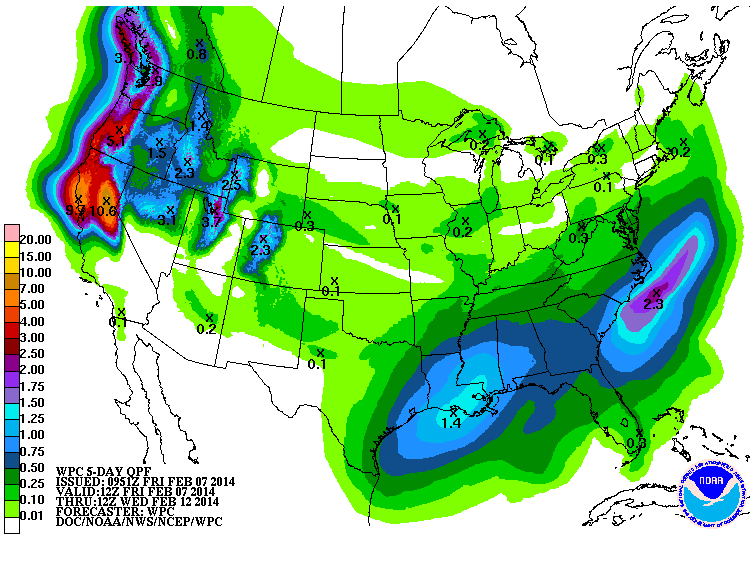California has been experiencing its driest weather in potentially 500 years. Fortunately, northern CA is finally getting some rain. Here’s NOAA’s precipitation forecast for the continental US for Feb.7-12 (created on the afternoon of Feb.7). “When it rains it pours.” Note the predicted amounts for northern CA:
The forecast precipitation won’t be nearly enough to break the drought (details below) but it’ll help.
The source of the moisture is an “atmospheric river”. From California Weather Blog:
“Atmospheric rivers” are long and narrow bands of highly-concentrated water vapor that occur in association with extratropical cylones (i.e. winter storms) throughout the Earth’s middle latitudes, especially over and near ocean basins. These features are often associated with extreme precipitation and flooding, especially along the mountainous western coast of North America (including California). To put the magnitude of these events in context: atmospheric rivers are (in aggregate) responsible for over 90% of global atmospheric water transport between subtropical and mid-latitude regions, and a single strong event is capable of moving an amount of water equivalent to 15 times the flow rate of the Mississippi River!
Those familiar with California weather and climate can attest to the critical role played by atmospheric rivers in driving wintertime precipitation extremes. I’ve noted in the past that California is dependent on just a handful of significant storm events for the majority of its annual precipitation, and this handful is usually associated with atmospheric rivers. California’s great floods in the historical past were almost all associated with atmospheric rivers, including the spectacular event of 1861-1862–which filled much of the Central Valley with floodwaters and inundated the fledgling state capital in Sacramento. Interestingly, scientists recently highlighted the important role atmospheric rivers have played in breaking many of California’s historical droughts.
What does the this week’s weather in CA suggest about climate change? Nothing, in and of itself. Climate is about weather patterns not individual weather events. Is the 14 month drought in CA consistent with a change in weather pattern induced by anthropogenic warming? Perhaps. Here’s Joe Romm:
The good news: Parts of California are finally getting some much needed precipitation. As Climate Central notes, “a series of Pacific storm systems is producing sorely needed rain and mountain snowfall in California, which has been suffering from one of its worst droughts in at least 500 years.”
The storms are being driven by an “atmospheric river,” which, as NOAA explains, is a “relatively narrow” region in the atmosphere “responsible for most of the horizontal transport of water vapor outside of the tropics.” Climate Central has the graphic:
Satellite image of water vapor showing an atmospheric river approaching California from the tropics (square box). Credit: NOAA.
The bad news: Accuweather reports Friday that “In terms of the ongoing drought that has gripped parts of the West for years, the moisture with this system will only make a dent in the huge precipitation deficit that has occurred.”
As the map below reveals, for most of coastal and northern California, 15 to 36 (!) inches of rain would be needed to end the drought. But the northern half of California is projected to see only 2 to 4 inches of rain over the next several days, though some areas will see as much as 4-8.
The ugly news: As [this] chart from Bloomberg BusinessWeek reveals, California’s recent dry spells are growing longer and stronger.
This is consistent with my interviews of leading climate scientists and drought experts last week. Climatologist James Hansen told me, “Increasingly intense droughts in California, all of the Southwest, and even into the Midwest have everything to do with human-made climate change.” The warming by itself helps dry out the soil and reduce the snowpack, robbing the region of a reservoir needed for the summer dry season. But there is growing evidence that climate change and Arctic ice loss are leading to changes in weather patterns and stuck jet stream patterns of the exact kind that have been steering precipitation away from California over the past 12 months.
If the trend in warming-worsened droughts continues — and that seems inevitable given the world’s continued failure to reduce carbon pollution — then drought researcher Aiguo Dai’s warning will seem increasingly prescient: “The U.S. may never again return to the relatively wet conditions experienced from 1977 to 1999.” It is time to start planning for a permanent change in the climate of the West and Southwest.
Cross your fingers and hope for the best. Dumping CO2 into the atmosphere at the rate we are is a global-scale experiment. If it fails we will not have the opportunity for a do-over.



